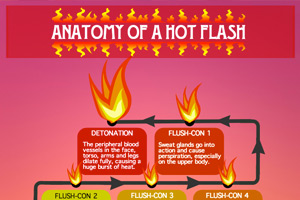
A study released last year surprised many when it suggested that more than 60% of divorces during menopausal years are initiated by the wife. Could there be a link between the frustration menopause symptoms bring and divorce?
One explanation for the high divorce rate when women are in their 40s, 50s or 60s centers around hormones. When a woman’s body begins producing less estrogen (which usually happens in perimenopause), there’s another hormone that’s affected. Levels of oxytocin, which is a feel-good hormone that is attributed to feelings such as love for others and even the urge to take care of one’s family, are seen to be significantly lower, too. Some doctors claim that the lack of oxytocin changes a woman’s thinking from a “we” mindset to a “me” mindset.
Sex also seems to be one of the larger contributing factors to the reasons for divorce. In fact, from the male perspective, 66% of men say a satisfying sex life is important to their overall quality of life. While about 12% of menopausal women claim to notice a decrease in their libido during the change, many medications prescribed to help with menopause, such as antidepressants or mood stabilizers, can also create this effect and negatively impact other facets of life as well.
There are dozens of menopause symptoms that can contribute to relationship stress and eventually divorce. Some of the most common menopausal symptoms that could add stress include:
- Hot flashes
- Night sweats
- Lowered sex drive
- Vaginal dryness
- Breast tenderness
- Mood swings
- Weight gain
- Headaches
It’s no surprise that a combination of these symptoms could create severe changes in mood or alter how a woman feels about herself or her relationship. Unfortunately, the added stress can sometimes result in mood swings or undue “unloading” on the husband, creating further problems in the marriage.
The good news is that the LadyCare therapeutic device has been shown to help 71% of women studied get relief from up to 24 different menopause symptoms, including low libido, vaginal dryness and mood swings. It’s also been used by many women post-menopause who still weren’t feeling like their previous selves with all the changes that had occurred in their bodies. LadyCare has been specially created to work with your body to help naturally relieve perimenopause and menopause symptoms.
While we certainly can’t make any promises about your relationship, we hope that you’re able to experience significant relief with LadyCare and eliminate any undue stress that menopause may have added to your marriage and your life.
If you’re searching for a natural menopause treatment, you can learn more about what LadyCare is and how it may provide relief to you here.
These statements and products have not been evaluated by the FDA. The products of this company are not intended to diagnose, prevent, heal, treat, or cure any disease or injury. If you have any pre-existing conditions, we advise you to check with your physician or healthcare provider prior to using. For external use only.

